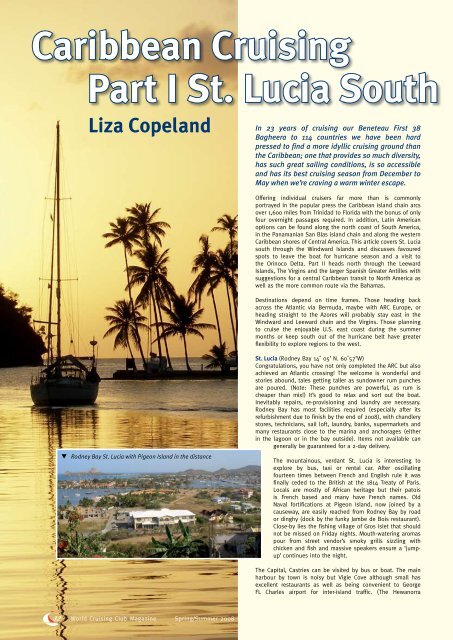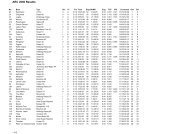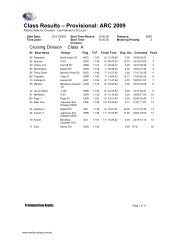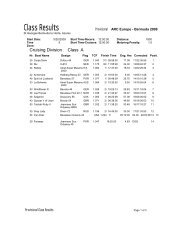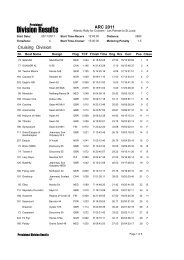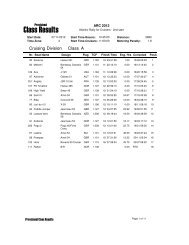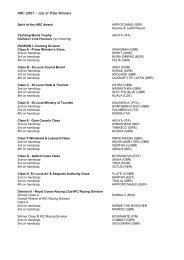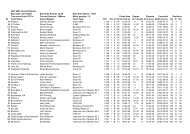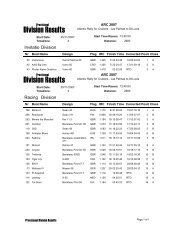Caribbean Cruising Part I St. Lucia South Liza Copeland
Caribbean Cruising Part I St. Lucia South Liza Copeland
Caribbean Cruising Part I St. Lucia South Liza Copeland
Create successful ePaper yourself
Turn your PDF publications into a flip-book with our unique Google optimized e-Paper software.
<strong>Caribbean</strong> <strong>Cruising</strong><br />
<strong>Part</strong> I <strong>St</strong>. <strong>Lucia</strong> <strong>South</strong><br />
<strong>Liza</strong> <strong>Copeland</strong><br />
q Rodney Bay <strong>St</strong>. <strong>Lucia</strong> with Pigeon Island in the distance<br />
32 World <strong>Cruising</strong> Club Magazine Spring/Summer 2008<br />
In 23 years of cruising our Beneteau First 38<br />
Bagheera to 114 countries we have been hard<br />
pressed to find a more idyllic cruising ground than<br />
the <strong>Caribbean</strong>; one that provides so much diversity,<br />
has such great sailing conditions, is so accessible<br />
and has its best cruising season from December to<br />
May when we’re craving a warm winter escape.<br />
Offering individual cruisers far more than is commonly<br />
portrayed in the popular press the <strong>Caribbean</strong> island chain arcs<br />
over 1,600 miles from Trinidad to Florida with the bonus of only<br />
four overnight passages required. In addition, Latin American<br />
options can be found along the north coast of <strong>South</strong> America,<br />
in the Panamanian San Blas island chain and along the western<br />
<strong>Caribbean</strong> shores of Central America. This article covers <strong>St</strong>. <strong>Lucia</strong><br />
south through the Windward Islands and discusses favoured<br />
spots to leave the boat for hurricane season and a visit to<br />
the Orinoco Delta. <strong>Part</strong> II heads north through the Leeward<br />
Islands, The Virgins and the larger Spanish Greater Antilles with<br />
suggestions for a central <strong>Caribbean</strong> transit to North America as<br />
well as the more common route via the Bahamas.<br />
Destinations depend on time frames. Those heading back<br />
across the Atlantic via Bermuda, maybe with ARC Europe, or<br />
heading straight to the Azores will probably stay east in the<br />
Windward and Leeward chain and the Virgins. Those planning<br />
to cruise the enjoyable U.S. east coast during the summer<br />
months or keep south out of the hurricane belt have greater<br />
flexibility to explore regions to the west.<br />
<strong>St</strong>. <strong>Lucia</strong> (Rodney Bay 14˚ 05’ N. 60˚57’W)<br />
Congratulations, you have not only completed the ARC but also<br />
achieved an Atlantic crossing! The welcome is wonderful and<br />
stories abound, tales getting taller as sundowner rum punches<br />
are poured. (Note: These punches are powerful, as rum is<br />
cheaper than mix!) It’s good to relax and sort out the boat.<br />
Inevitably repairs, re-provisioning and laundry are necessary.<br />
Rodney Bay has most facilities required (especially after its<br />
refurbishment due to finish by the end of 2008), with chandlery<br />
stores, technicians, sail loft, laundry, banks, supermarkets and<br />
many restaurants close to the marina and anchorages (either<br />
in the lagoon or in the bay outside). Items not available can<br />
generally be guaranteed for a 2-day delivery.<br />
The mountainous, verdant <strong>St</strong>. <strong>Lucia</strong> is interesting to<br />
explore by bus, taxi or rental car. After oscillating<br />
fourteen times between French and English rule it was<br />
finally ceded to the British at the 1814 Treaty of Paris.<br />
Locals are mostly of African heritage but their patois<br />
is French based and many have French names. Old<br />
Naval fortifications at Pigeon Island, now joined by a<br />
causeway, are easily reached from Rodney Bay by road<br />
or dinghy (dock by the funky Jambe de Bois restaurant).<br />
Close-by lies the fishing village of Gros Islet that should<br />
not be missed on Friday nights. Mouth-watering aromas<br />
pour from street vendor’s smoky grills sizzling with<br />
chicken and fish and massive speakers ensure a ‘jumpup’<br />
continues into the night.<br />
The Capital, Castries can be visited by bus or boat. The main<br />
harbour by town is noisy but Vigie Cove although small has<br />
excellent restaurants as well as being convenient to George<br />
FL Charles airport for inter-island traffic. (The Hewanorra
p An enterprising local brings<br />
produce to the yachts<br />
International airport is at the south end of<br />
the island at attractive Vieux Fort with direct<br />
flights to the UK.) Castries has an extensive<br />
market, particularly vibrant on Saturdays,<br />
good supermarkets and a few old buildings<br />
remain around the central Derek Walcott<br />
Square. Customs can be cleared in Castries<br />
but it is far easier in Rodney Bay and Marigot,<br />
especially when cruise ships visit.<br />
Marigot Bay is one of the <strong>Caribbean</strong>’s<br />
jewels with its picturesque sandy spit and<br />
palms although there has been extensive<br />
development. Dock space or mooring buoys<br />
may be available otherwise anchor inside or<br />
outside the buoyed entrance channel. There are<br />
several restaurants. Check out the mangroves<br />
to hear the tiny but incredibly noisy tree frogs<br />
and climb the steep hill for a stunning view<br />
of the harbour. <strong>South</strong> of Marigot anchoring,<br />
diving and fishing is mostly regulated by the<br />
CMMA and SMMA organizations who operate<br />
mooring buoys. The basic rate is for two<br />
nights and they visit the yachts to collect the<br />
fee. At the northern bluff off Soufrière the<br />
snorkelling is colourful right under the buoys<br />
and around the headland large elkhorn coral<br />
is growing back after past hurricane damage.<br />
Soufrière is a charming old French town<br />
of weathered wooden structures adorned<br />
with gingerbred trim. It has good eating<br />
and shopping. Visits to the nearby bubbling<br />
sulphur springs, passing through verdant<br />
rainforest and cultivated valleys en route, and<br />
the Diamond Botanical garden that is alive<br />
with hibiscus, bougainvillea, heliconias and<br />
brilliant birds, are particularly worthwhile. Two<br />
tall peaks called The Pitons soar on <strong>St</strong>.<strong>Lucia</strong>’s<br />
southwest shore. They offer a challenge to<br />
climb and are fun for fitness.<br />
<strong>St</strong>. Vincent (Wallilabou 13˚15’N 61˚17’W)<br />
It is frequently an exhilarating 30nm broad<br />
reach south to <strong>St</strong>. Vincent although winds<br />
are often blustery off its north shore as<br />
they funnel around towering craggy peaks<br />
smothered in green. It was one of the last<br />
islands to be settled by Europeans and many<br />
cruisers pass it by, although Wallilabou Bay,<br />
(just south of Cumberland that is also an<br />
overnight anchorage) has gained popularity as<br />
it has the set for the ‘Pirates of the <strong>Caribbean</strong>’<br />
films. One actually clears customs on site!<br />
We found local ‘boat boys’ a little aggressive,<br />
unusual now in the islands.<br />
The capital Kingstown has some attractive<br />
buildings and is being re-developed. Prices<br />
are good in the well-stocked supermarkets<br />
and produce is excellent. The anchorage is<br />
p Free champagne at the resort between<br />
the Pitons.<br />
not ideal and many cruisers come here by bus or taxi from Young Island<br />
and Blue Lagoon in the south or by ferry from Bequia, a popular island<br />
for cruisers just an hour away. Close-by lies the oldest botanical gardens<br />
in the western hemisphere. Captain Bligh brought breadfruit here after<br />
his ill-fated Bounty voyage.<br />
The <strong>St</strong>.Vincent Grenadines<br />
Bequia (Admiralty Bay 13˚00’N 61˚15W)<br />
Bequia has retained its colourful laid-back charm. Sheltered Admiralty<br />
Bay holds large numbers of yachts and ashore delightful facilities keep<br />
cruisers here for weeks. Buoys are available, there is also a small marina,<br />
or anchor either side of the central ferry channel but watch the depth.<br />
Holding can be tricky, generally better by the outer white sand Tony<br />
Gibbons Beach (Princess Margaret). Officials are located in the centre<br />
of Port Elizabeth. There are two dinghy docks in town, with garbage<br />
facilities at the northern one by the market; prices are high here and<br />
vendors quite persistent. It’s best to spread business around.<br />
Check with the helpful tourist office at the head of the ferry dock for<br />
the events of the week sheet. ‘Happy<br />
hours’ are abundant with a steel band at<br />
the Calabash every Thursday, and much<br />
more besides. (Call VHF Channel 68 or<br />
16 for most bookings.) The Whaleboner<br />
has a bar made from a whale’s jawbone<br />
with stools from vertebrae. Bequians are<br />
descendents of Africans, French, Scots and<br />
Americans who introduced whaling boats<br />
in 1875. Using open boats and harpoon<br />
their season is during the winter months<br />
when the Humpbacks are heading south<br />
(currently four whales are allowed each<br />
year). We’ve only been there once when<br />
a whale was towed in and the stench was<br />
memorable as they boiled up its blubber<br />
on the beach! Bequians still build boats<br />
and make amazing model yacht replicas if<br />
supplied with pictures and dimensions.<br />
There are several small technical,<br />
chandlery, sails and canvas facilities.<br />
Internet cafés are abundant, with free<br />
WiFi in some restaurants. A convenient<br />
launderette is to the left of the market up<br />
the hill. Knights, just off the waterfront<br />
street north of Customs, is a general<br />
supermarket with many other stores<br />
selling some different products. Doris<br />
Fresh Foods opposite the market has<br />
higher end items as well and there are<br />
several boutiques.<br />
Mustique (12˚52.7’N 61˚11.4W)<br />
Although lying just 10 miles south-east<br />
of Bequia the sail to Mustique can often<br />
be a slog to windward in turbulent seas,<br />
although a stop at Bequia’s southern<br />
Friendship Bay breaks the trip. There are<br />
mandatory mooring buoys in Britannia<br />
Bay, the only anchorage allowed in<br />
Mustique, with a park fee. Make sure you<br />
p Roughing it on board!<br />
p The large Admiralty Bay,<br />
Bequia<br />
p Don't worry about<br />
clothing - there is plenty<br />
to buy!<br />
www.worldcruising.com Spring/Summer 2008 World <strong>Cruising</strong> Club Magazine<br />
33
p A <strong>Caribbean</strong> jewel, Marigot Bay p 'Boat boys' arrive on varying craft. They<br />
are seldom aggressive these days but try<br />
creative pricing!<br />
avoid Montezuma’s reef unlike the French<br />
cruise liner the Antilles in 1971. It was still on<br />
fire when I visited several months later.<br />
In 1958 Mustique was bought by the Hon.<br />
Colin Tennant to be an island for the rich<br />
and famous, and the late Princess Margaret<br />
accepted his gift of a 10-acre plot as a<br />
wedding present. Now managed by the<br />
Mustique Company it is charming to visit.<br />
Basil’s Bar by the beach is entertaining and a<br />
picturesque walk north leads to the old-world<br />
Cotton House, originally an 18th century coral<br />
warehouse and sugar mill, with a mesmerising<br />
stop to watch small planes land downhill on<br />
the small runway – not unusual in this part of<br />
the world!<br />
Canouan (12˚42.6N 61˚20’W)<br />
An island in transition by development. It has<br />
a Moorings charter fleet based in Charlestown<br />
Bay, but as this main anchorage can get<br />
uncomfortable, it is little visited by cruisers.<br />
The Tobago Cays (12˚40’N 61˚21.4’W)<br />
Many charterers spend their holiday in<br />
this group of white sand deserted islands<br />
anchored in brilliant turquoise seas sheltered<br />
by the large Horseshoe Reef. It is ‘what<br />
dreams are made of’ but if you have flexibility<br />
avoid the main crowds mid-January to mid-<br />
March, if not you will enjoy it anyway! The<br />
snorkelling/diving is rewarding, the green<br />
turtles have recently returned and inquisitive<br />
iguanas rustle in the scrub as one climbs to<br />
the tops of rough paths ashore to stunning<br />
views. Most boats anchor outside by the<br />
reef although anywhere around the islands<br />
is permissible in sand. <strong>St</strong>udy the chart and<br />
cruising guides carefully before approaching<br />
and follow the golden rule regarding the<br />
sun (see <strong>Cruising</strong> notes). There is a park fee.<br />
Friendly vendors sell bread, produce, lobster,<br />
T-shirts etc: from their colourful boats.<br />
Mayreau (12˚38.9’N 61˚23.5’W)<br />
Lying just to west, Mayreau has some pretty<br />
beaches with enterprising locals who set up<br />
stalls and offer dining ashore. Sandy Salt<br />
Whistle Bay is a favourite and it is wise to<br />
arrive early in season, or anchor in Saline Bay.<br />
Snorkelling can be rewarding on the windward<br />
side but, as with Tobago Cays, watch the<br />
westward current.<br />
PSV and Petite Martinique<br />
(PSV 12˚32’N 61˚23’W )<br />
Although these lie south of Union and Palm<br />
Island, Petit <strong>St</strong>.Vincent (PSV) is part of <strong>St</strong>.<br />
Vincent so should be visited before clearing<br />
out at Union. Petit Martinique is officially part of Grenadian waters but it<br />
seems accepted that most cruisers will visit from PSV. The entire island<br />
of PSV is an exclusive hotel. Since the 60’s it has been one of our<br />
favourite anchorages with its white sand beaches ashore. Access is now<br />
limited for yachtsmen to using the bar and restaurant which are well<br />
worth a visit both for their wicked banana daiquiris and the stunning<br />
view of translucent turquoise and sapphire seas. Just to the south Petit<br />
Martinique, originally a smugglers island, has bargain fuel, French wine,<br />
and restaurants. Judging by the ancient ages on the gravestones the<br />
life has suited the locals! A large reef lies to the north of PSV and it<br />
is important not to cut the corner when heading northwest. Watch for<br />
boats swinging at PSV if the wind dies.<br />
Union and Palm Island<br />
(Clifton 12˚35.7’N 61˚24.9’W)<br />
Entry to the small but bustling port of Clifton gives a spectacular example<br />
of an area studded with reefs. Look at the charts well in advance,<br />
particularly when approaching from the north. There are some small dock<br />
facilities with water and fuel available or anchor off. Customs are in town<br />
along with several shops, market stalls,<br />
boating facilities and internet cafes. This<br />
is the Port of Entry for clearing in or out<br />
of <strong>St</strong>. Vincent Waters.<br />
Prune Island was renamed Palm Island<br />
by the Caldwells who planted palm<br />
trees throughout the islands and first<br />
developed this island. It is now a highend<br />
resort but the white sand beach full<br />
of pale pink ‘chipchip’ shells is a lovely<br />
day anchorage in light winds.<br />
Grenadian Waters<br />
Carriacou (Tyrrel Bay (12˚27’N 61˚29’W)<br />
Off the tourist trail the hilly island of<br />
Carriacou has become a popular haven<br />
for long-term cruisers. Anchor in the<br />
pale aqua ocean and leave the dinghy<br />
at the long pier to clear into Grenadian<br />
waters with the officials and to shop in<br />
Hillsborough, the Capital, then move to<br />
the south side of protected Tyrrel Bay.<br />
Here facilities abound with restaurants,<br />
small grocery stores, shops, internet<br />
facilities, The small Tyrrel Bay Haul Out<br />
and marina and other boating facilities.<br />
Cruisers have become involved in the<br />
local community and for seven years have<br />
held the Carriacou Children’s Educational<br />
Fundraiser. Pelicans are common here<br />
and recently a leatherback turtle laid her<br />
eggs, the first time for years. Mangrove<br />
oysters are a popular delicacy.<br />
Grenada<br />
(<strong>St</strong>.Georges 12˚02.7’N 61˚44.8’W)<br />
Fourteen miles south of Carriacou lies<br />
the spectacular spice island of Grenada.<br />
Aromas of spices waft over the water<br />
from this mountainous, lush island<br />
p Bagheera on a mooring<br />
buoy at Soufriere with<br />
great snorkelling closeby<br />
p Attractive Soufriere with its<br />
French creole buildings<br />
with gingerbread trim<br />
p <strong>St</strong>. <strong>Lucia</strong> is a stunning<br />
towering verdant island,<br />
it's worth taking time to<br />
explore<br />
QUIET CARIBBEAN<br />
www.worldcruising.com Spring/Summer 2008 World <strong>Cruising</strong> Club Magazine 35
p A bird tour in Tobago, enjoying our<br />
guides powerful 'scope<br />
that was aptly nicknamed the ‘the banana<br />
bread island’ by our 4-year old son after we<br />
completed the ARC in 1986. An interior hike in<br />
the rainforest is a must, cooling off in one of<br />
the many waterfalls or mountain streams and<br />
seeing the cultivation that supplies much of<br />
the island chain.<br />
The reach south from Carriacou is generally<br />
an easy one with gusts funnelling through the<br />
mountains giving exhilarating sails, alternating<br />
with calms, in flat seas. In contrast, coming<br />
north can be hard on the wind. With the<br />
exception of small bays <strong>St</strong>. Georges, the<br />
vibrant capital, provides the main anchorage<br />
on the west coast. The bustling town climbs<br />
up the hill from the Carenage where anchoring<br />
is discouraged. The lagoon has recently been<br />
transformed by the recently opened Peter de<br />
Savary and Camper and Nicholson Marinas<br />
into the luxury Port Louis development.<br />
Between the bays lies the yacht club where<br />
we enjoyed watching spirited local kids in the<br />
sailing programme.<br />
The many bays of the south coast have been<br />
subject to much development, particularly<br />
Prickly Bay (l’Anse Aux Epines), but are still<br />
attractive to cruise. Considered south of the<br />
hurricane belt (although devasted in 2004 by<br />
Ivan) there are several marine facilities and<br />
yards with considerable ongoing expansion.<br />
The area is approved for hurricane season<br />
boat storage by most insurance companies,<br />
with certain parameters. Customs clearance<br />
is possible at Port Louis in <strong>St</strong>. Georges,<br />
The Moorings at True Blue Bay, Spice Island<br />
Marine in Prickly Bay, and at Grenada Marine<br />
in <strong>St</strong>. Davids.<br />
Trinidad and Tobago<br />
(Chaguaramus 10˚40.5’W 61˚38.3W)<br />
80 miles south of Grenada lies Trinidad’s<br />
sheltered Chaguaramus Bay approached<br />
through the narrow Boca that has strong<br />
currents. Sadly we found the beaches on<br />
the islands here extremely dirty. A U.S. Naval<br />
base during the war, the bay’s west end is<br />
commercial while its east end houses wall to<br />
wall boatyards with some small marinas and<br />
large Crews Inn hotel/marina complex with the<br />
Customs dock at the east end. Paperwork is<br />
strict here and hefty overtime may be charged.<br />
It is possible to pick up a mooring buoy or<br />
anchor off in Chaguaramus and around in<br />
Carenage Bay by the hospitable SSCA club<br />
although this anchorage becomes rolly in a<br />
southerly wind.<br />
Boating facilities are sophisticated as is the<br />
p Palm hats give good protection<br />
from the sun<br />
cosmopolitan and fun capital Port of Spain. The local cruisers ‘chaperone’,<br />
the lively and well organised Jesse James (Members Only), runs regular<br />
tours to shopping centres, markets and carnival events all announced<br />
on the morning VHF net at 8.00am VHF 68, along with bridge games,<br />
Mexican dominoes etc: Many cruisers moor here all winter and boats<br />
pour in for the February carnival. The culture of carnival has deep roots<br />
for Trinidadians and the outstanding costumes and pan (steel) bands<br />
take 6-months to prepare. The Asa Wright nature reserve, the scarlet ibis<br />
coming to roost in the mangroves at dusk and the spiritual experience<br />
of watching a leatherback turtle lay 100 or so eggs are all worthwhile<br />
trips. Talk to local cruisers about security at anchor and safety walking<br />
ashore.<br />
Unlike commercial Trinidad, Tobago, which unfortunately lies to windward,<br />
is a rural and bird paradise with beautiful white sand bays. Clearance is<br />
completed at Scarborough and Charlotteville, then anchorages chosen<br />
depending on weather conditions.<br />
Venezuela<br />
Orinoco Delta – Manamo River<br />
(9˚58.5’N 62˚15’W)<br />
Although few cruisers visit, it is just a<br />
day-sail south from Chaguaramus to the<br />
Manamo River, Venezuela, part of the<br />
Orinoco Delta. Water hyacinths stream<br />
around the boat as thousands of the<br />
large scarlet ibis birds peck in the mud<br />
flats, then come to roost in selected<br />
trees, their wings flashing red in unison<br />
illuminated by the last rays of the sun.<br />
Dawn and dusk also brings greetings<br />
from pink river dolphins, noisy parrots,<br />
howler monkeys and toucans. There are<br />
a few eco-lodges but mostly the river is<br />
deserted with just a few villages of the<br />
local people, the Warao, Indians, probably<br />
the most simply living people we have<br />
ever experienced. Although the chart<br />
marks a complicated river bar entrance<br />
there is now a deep-water shipping<br />
channel to service the oil rigs with clear<br />
channel markers. Informal customs is in<br />
the small town of Pedernales.<br />
Testigos (11˚23’N 63˚08W))<br />
Los Testigos is a remote paradise where<br />
we were given lobster by the locals.<br />
Clearance on the southerly island is for<br />
three days but, similar to Pedernales,<br />
does not cover the rest of Venezuela.<br />
Margarita Island<br />
(Porlamar 10˚56.7’N 63˚50W)<br />
The big, but shallow bay at Porlamar<br />
in duty free Margarita is popular with<br />
cruisers. Enterprising vendors will deliver<br />
fuel to your boat (Approx 1p per litre for<br />
diesel, 2p for petrol!). There have been<br />
some security issues in the outer bay.<br />
p Local markets are plentiful<br />
and locals full of<br />
information about how to<br />
eat their produce<br />
p In Wallilabou Bay, <strong>St</strong><br />
Vincent the customs<br />
office is on the set of the<br />
'Pirates of the <strong>Caribbean</strong>'<br />
films<br />
p The small village with<br />
customs office in Los<br />
Testigos, Venezuela<br />
www.worldcruising.com Spring/Summer 2008 World <strong>Cruising</strong> Club Magazine<br />
p The culture of<br />
carnival runs deep in<br />
Trinidad, special effort<br />
goes into the kids<br />
37
p A gift from the fishermen! Testigos,<br />
Venezuela<br />
Puerta La Cruz (10˚12.4’N 64˚40’W)<br />
Otherwise stay a distance off the Venezuelan<br />
north coast for security and head for Cumana<br />
on the mainland to buy fuel or straight to<br />
Puerto la Cruz (PLC) (no fuel for yachts).<br />
Currently it is not wise to stop at the coastal<br />
<strong>Cruising</strong> Tips<br />
1 Weather - The recognised <strong>Caribbean</strong><br />
hurricane season runs from June 1st to<br />
November 30th. About 75% of hurricanes and<br />
tropical storms occur between August and<br />
October, peaking in September. Dry season<br />
runs from January to June. Out of hurricane<br />
period the trade winds average a consistent<br />
10-25 knots from NE-SE, tending to be NE<br />
early in the season and SE later, and gust<br />
around the islands’ north ends. Visibility is<br />
generally good although can be hazy and is<br />
considerably reduced in squalls. Check your<br />
cruising guide for weather radio, VHF, SSB<br />
and Ham frequencies, also at boating facilities<br />
ashore and the internet for forecasts. Cruiser’s<br />
nets also give weather. Boaters in the<br />
<strong>Caribbean</strong> commonly listen to Chris Parker on<br />
SSB 8104khz at 8.30am local which follows<br />
Melodye Pompa’s (Second Millennium) Safety<br />
and Security net at 8.15am. Those who can<br />
download e-mail get weather GRIB files.<br />
2 Pilotage - Have detailed charts, piloting<br />
through the reefs particularly in the Grenadines<br />
can be deceptive. Imray charts are particularly<br />
user-friendly. We use Nobeltec and C-Map<br />
electronic charting effectively (note: both<br />
are now owned by Jeppersen Marine and the<br />
combined version will be launched shortly).<br />
<strong>Cruising</strong> Guides are a great asset for harbour<br />
charts and information. The Windward Islands<br />
by Chris Doyle (<strong>Cruising</strong> Guide Publications)<br />
and Imray’s <strong>Cruising</strong> Guide from Grenada to<br />
the Virgin Islands (2nd Edition 2008) are<br />
popular.<br />
Navigational aids cannot be relied on. The<br />
American system ‘red right returning’ is used<br />
throughout the <strong>Caribbean</strong>.<br />
Current There is generally a westerly set.<br />
Watch carefully while snorkelling.<br />
Advance planning – It is crucial when cruising<br />
through reef strewn regions that the sun is<br />
overhead or behind. If in your eyes you will not<br />
see the colours change to lighter hues or browns<br />
that indicate shallow waters and reefs respectively<br />
Polaroid glasses intensify the colours.<br />
p The ubiquitous cruisers'<br />
'pot luck'<br />
islands or Mochima Park. PLC has an expensively developed large lagoon<br />
with numerous excellent facilities and yards for boats, good shopping and<br />
a comfortable marina/hotel complex Bahia Redonda, as well as others.<br />
Here agents are available to clear customs or one can do it oneself with<br />
some effort. Vendors will also change money at the ‘local’ rate (currently<br />
around 5 bolivars to the US$1 as compared to the bank rate of 2.1).<br />
US dollars and Euros are preferred. Technical work is inexpensive and<br />
good, but should be overseen. Credit cards are generally not taken by the<br />
yards and using them doesn’t give the benefit of the street exchange rate<br />
obtained with cash. Check with local cruisers regarding security locally<br />
and in town. Several agents within the marina complex arrange tours for<br />
spectacular travel inland.<br />
3 Moorage/Anchoring There are few marinas. Electricity can either be<br />
110 or 220 and a duel voltage battery charger is useful and a multiplug<br />
adapter for use ashore. Anchoring is the norm. Look for white sand<br />
patches, never anchor in coral. Although many use the traditional Bruce<br />
and CQR the newer anchors such as the Spade types and the Delta are<br />
becoming popular as effective for penetration particularly if one has<br />
to anchor in seagrass. Most cruisers now use all chain and an electric<br />
windlass which facilitates easy ‘gunkholing’ and changing anchorage if<br />
the wind changes. It also effortlessly gets someone up the mast and the<br />
dinghy on deck.<br />
4 Officials – Clear in at a Port of Entry immediately on entering a<br />
country’s waters. Fees vary but are generally reasonable. Officials have<br />
working hours and many charge overtime, particularly Trinidad where<br />
you must also report if you depart for a period and leave the boat at<br />
the marina. Only the skipper should go ashore with ship’s papers and<br />
crew passports. Making crew lists in advance with boat details – name,<br />
registration, length etc and net tonnage, and having a copy of ship’s<br />
documents can save time. <strong>St</strong>. Vincent and Grenada have streamlined the<br />
procedure to one page with five copies – press hard! Clearing out of<br />
a country is mandatory before being able to clear into the next. Have<br />
quarantine and country flag flying from the starboard spreader on arrival.<br />
Always dress conservatively and be polite!<br />
5 Water and Fuel – Water is potable throughout the islands and available<br />
at marinas and the major centres. There is sometimes a charge. Fuel is<br />
also readily available.<br />
6 Deck Canvas/Ventilation Although we are always quizzed about<br />
pirates and sharks, the sun is your greatest danger. Use a hat, sun block<br />
and don’t rush getting a tan. A bimini is a must, preferably with good<br />
headroom, also a dodger with large opening central panel for a good air<br />
flow at anchor. Side curtains on the lifelines by the cockpit reduce UV<br />
burn reflected from the water. Below fans are a must over every berth and<br />
in the main cabin and particularly in the galley that also ideally has an<br />
opening port. Windscoops also increase the airflow below.<br />
7 Security It is wise to lock your boat, secure the dinghy with a wire or<br />
chain cable and<br />
padlock the outboard to the stern pulpit or dinghy. Raise dinghy at<br />
night on a halyard if concerned. Have a companionway hatch that allows<br />
airflow for the night. We have had no problems but talk to other cruisers<br />
before and when you arrive particularly in Trinidad and Venezuela. Some<br />
anchorages are more vulnerable. Recently local authorities have become<br />
geared to stop theft from yachts.<br />
8 Local boaters The local brightly coloured boats are picturesque but<br />
the local lads have large outboards and love to speed, at times going<br />
QUIET CARIBBEAN<br />
www.worldcruising.com Spring/Summer 2008 World <strong>Cruising</strong> Club Magazine 39
too close to anchored yachts. If swimming/<br />
snorkelling always keep a good look out.<br />
There are seldom aggressive ‘boat boys’ these<br />
days. In some anchorages, particularly in the<br />
Grenadines, vendors circulate the boats with<br />
goods for sale. Prices are higher than the<br />
norm as would be expected but it does not<br />
help in the long run to pay too much. Note:<br />
lobster season is from 1st October- 30th April.<br />
It is illegal to buy outside those months, and<br />
a female at any time.<br />
9 Beasties and Berries<br />
Manchineel – is frequently found growing<br />
on beaches. This tree with bright green/<br />
yellow leaves and small apples, is extremely<br />
poisonous. Do not stand under one in a rain<br />
shower, collect the wood for a BBQ and do<br />
not eat the apples.<br />
Cockroaches and mosquitoes – seldom<br />
a problem in winter but have repellent<br />
cockroach ‘hotels’ or boric acid handy. Check<br />
packages for cockroach eggs before bringing<br />
aboard.<br />
Snakes – Although rare <strong>St</strong>. <strong>Lucia</strong> is home to<br />
the deadly Fer de Lance.<br />
Fish etc: – Sharks and barracuda are not a<br />
danger when swimming unless harassed but<br />
it is considered unwise to eat barracuda over<br />
3lbs as they may contain ciguatera toxin. Be<br />
careful not to step on the spiny black sea<br />
urchins. Spines should not be pulled out of<br />
the skin but treated with hot lime juice to<br />
dissolve them. Watch out for fish traps buoyed<br />
with bamboo or plastic bottles.<br />
Weevils and flour moths – lay their eggs in<br />
anything made of grains, seeds or nuts. They<br />
penetrate plastic bags. Bay leaves seem to<br />
discourage these bugs or treat them as extra<br />
protein!<br />
10 Fishing – Tow a feather or plastic squid<br />
for tuna, dorado (mahi mahi) and many others<br />
at 6 knots or more just skipping the surface.<br />
To subdue, squirt alchohol (rum!) into its<br />
mouth or over the inside gills before bringing<br />
on board – we have ours in a ‘squeezy’ bottle<br />
at hand. Be aware of areas where fishing is<br />
not allowed (listed in cruising guides and<br />
given by customs), which includes much of the<br />
Grenadines, and where reefs are protected.<br />
11 Boat Supplies – Budget Marine and Island<br />
Water World, both head offices located in<br />
<strong>St</strong>.Maarten, are comprehensive chandlers with<br />
stores or delivery throughout the islands.<br />
There are many other stores, technicians and<br />
facilities throughout.<br />
x Good use was<br />
made of the bosun's<br />
chair while anchored<br />
in Tobago cays!<br />
Tourist Tips<br />
1 Research - Buy resource books on travel, birds, fish, underwater etc:<br />
before you leave and read them transatlantic so you are well prepared to<br />
make the most of your <strong>Caribbean</strong> sabbatical. I’ve just covered the tip of<br />
the iceberg, there is so much to see!<br />
2 Culture - Be curious and accommodating about the local culture and<br />
customs, interact with the local people, try their food, be inquisitive in<br />
the markets, see the sights and explore their lands. Much is different to<br />
home but all part of the adventure. Misunderstandings tend only to occur<br />
to those who are aloof.<br />
3 Dress - The islanders dress conservatively, especially on church days,<br />
and do not respect women who don’t. Look smart to clear with officials<br />
and women are advised to wear pants or a skirt in town. Otherwise dress<br />
is light and casual with covering for the sun. The year-round temperature<br />
is 27-32˚ C.<br />
4 Language – English is spoken throughout these Windward Islands,<br />
with the locals having their own patois mixes, and Spanish in Venezuela.<br />
5 Communications – GSM phones with local SIM cards are used.<br />
Internet cafes are found in all the main boating centres and often free<br />
WiFi in restaurants. Using Skype to phone on the internet is popular.<br />
Booster antennae can be useful to pick up the Internet from the boat.<br />
International direct dial from all phones with phone cards available.<br />
6 Finances - These Windward Islands all use the $EC which is linked<br />
EC$2.67 with the US$1, and will also accept $US cash. Be sure to establish<br />
which currency taxis etc. are quoting – and establish a price first. Bank<br />
machines are readily available. Have cards on both the Plus and Cirrus<br />
systems. In Trinidad TT$6.3 = US$1 ($12.75=£1). For Venezuela see text.<br />
7 Security – Seldom a problem on shore in the Windwards, there have<br />
been problems in Trinidad and Venezuela. Check with cruisers ahead and<br />
on arrival. Take the usual precautions ashore with cameras and bags, and<br />
avoid walking in towns at night.<br />
8 Health – good medical and dental care especially in Venezuela<br />
although facilities can look rough in the islands. Be insured for overseas<br />
travel.<br />
9 Photography – a photographer’s dream! If you have a large SLR you<br />
might also consider an additional small camera that is convenient and<br />
inconspicuous to carry ashore and keep dry. Always ask permission to<br />
photograph people, many still view a camera as the ‘evil eye’. People<br />
love to see themselves in the viewfinder, printing a photo for them makes<br />
a great gift.<br />
<strong>Liza</strong> is the award-winning, best-selling author of four books. Just <strong>Cruising</strong><br />
and <strong>St</strong>ill <strong>Cruising</strong> recount her family travels around the world; Comfortable<br />
<strong>Cruising</strong> tells of their voyage around North and Central America; and<br />
<strong>Cruising</strong> for Cowards, co-authored with Andy (2nd Edition just published<br />
and available at bookharbour.com), is their practical how-to text. She has<br />
also assisted directing a DVD Just <strong>Cruising</strong>, writes for several magazines<br />
and gives seminars at boatshows and for a variety of organizations on<br />
boating and travel. Their 40’ 1985 Beneteau Bagheera has now completed<br />
over 114,000 miles and visited 114 countries and is still enjoyed and used by<br />
the entire family.<br />
y Relaxed<br />
Island sailing<br />
and researching<br />
the next stop<br />
QUIET CARIBBEAN<br />
y Bagheera was frequently<br />
surrounded by water<br />
hyacinths in the Orinoco Delta<br />
www.worldcruising.com Spring/Summer 2008 World <strong>Cruising</strong> Club Magazine 41


